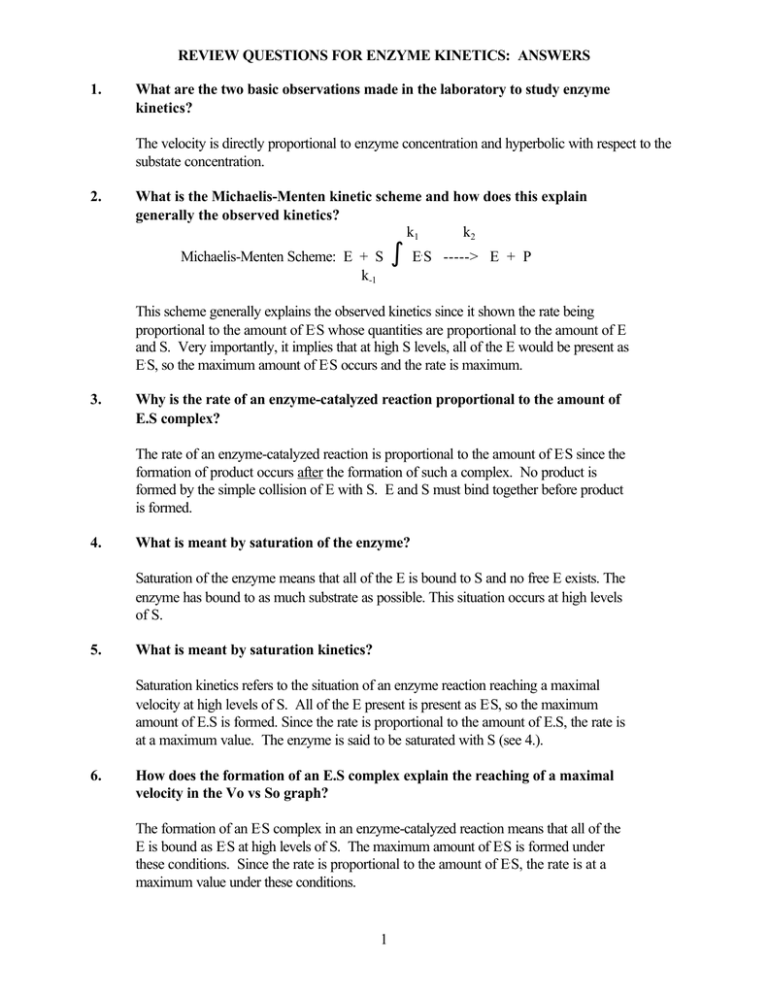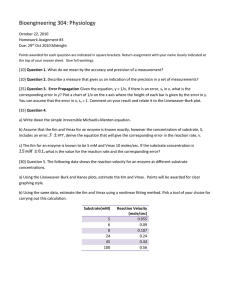1 REVIEW QUESTIONS FOR ENZYME KINETICS: ANSWERS 1
advertisement

REVIEW QUESTIONS FOR ENZYME KINETICS: ANSWERS 1. What are the two basic observations made in the laboratory to study enzyme kinetics? The velocity is directly proportional to enzyme concentration and hyperbolic with respect to the substate concentration. 2. What is the Michaelis-Menten kinetic scheme and how does this explain generally the observed kinetics? k1 k2 Michaelis-Menten Scheme: E + S k-1 º ES . -----> E + P This scheme generally explains the observed kinetics since it shown the rate being proportional to the amount of E. S whose quantities are proportional to the amount of E and S. Very importantly, it implies that at high S levels, all of the E would be present as E. S, so the maximum amount of E. S occurs and the rate is maximum. 3. Why is the rate of an enzyme-catalyzed reaction proportional to the amount of E.S complex? The rate of an enzyme-catalyzed reaction is proportional to the amount of E. S since the formation of product occurs after the formation of such a complex. No product is formed by the simple collision of E with S. E and S must bind together before product is formed. 4. What is meant by saturation of the enzyme? Saturation of the enzyme means that all of the E is bound to S and no free E exists. The enzyme has bound to as much substrate as possible. This situation occurs at high levels of S. 5. What is meant by saturation kinetics? Saturation kinetics refers to the situation of an enzyme reaction reaching a maximal velocity at high levels of S. All of the E present is present as E. S, so the maximum amount of E.S is formed. Since the rate is proportional to the amount of E.S, the rate is at a maximum value. The enzyme is said to be saturated with S (see 4.). 6. How does the formation of an E.S complex explain the reaching of a maximal velocity in the Vo vs So graph? The formation of an E. S complex in an enzyme-catalyzed reaction means that all of the E is bound as E. S at high levels of S. The maximum amount of E. S is formed under these conditions. Since the rate is proportional to the amount of E. S, the rate is at a maximum value under these conditions. 1 REVIEW QUESTIONS FOR ENZYME KINETICS: ANSWERS, continued 7. Explain mathmematically how a value for Km can be obtained from the Vo vs So graph when Vo = 1/2 Vmax. When Vo = Vmax/2, then Vmax/2 = Vmax. So , Km + So cancelling Vmax, 1/2 = So or Km + So = 2So Km + So or Km = So at Vo = (value of) Vmax/2 8. What is the Michaelis-Menten equation and its Lineweaver-Burk form? M-M equation Vo = Vmax So L-B eqn: 1/Vo = Km/Vmax(1/So) + 1/Vmax Km + So 9. How does the Michaelis-Menten equation explain why the rate of an enzyme-catalyzed reaction is proportional to the amount of enzyme? In the M-M equation above Vmax = k2Eo. In the experiment of Vo vs Eo, So is held constant so all other terms, So, Km, are constant. So Vo = constant Eo or Vo is proportional to Eo. 10. How does the Michaelis-Menten equation explain why the rate of an enzyme-catalyzed reaction reaches a maximum value at high substrate? At high So, Km <<<< So (numerically), so the term Km + So in the M-M equation becomes equal to So. Vo = (Vmax So)/So, and So cancels. Therefore at high So then, Vo = Vmax. 11. What type of enzyme inhibition does the following graph indicate? What can you say about the chemical similarities or differences between the substrate and the inhibitor? The type of inhibition is noncompetitive. This implies that the substrate and the inhibitor are not structurally and chemically alike. 2 REVIEW QUESTIONS FOR ENZYME SPECIFICITY AND CATALYSIS: ANSWERS 1. What is the chemical basis of enzyme specificity? The chemical basis of enzyme specificity is the complimentary relationship between the enzyme active site and the substrate that binds in that site. This complimentarity involes a structural fit of the S into the E active site (a "lock and key" kind of fit) and a chemical complimentarity. For example if the E has H-bond donating groups, the S will have H-bond accepting groups and vise versa, or that there will be an opposite charge relationship between groups on the E and S. In addition of there are nonpolar groups on the S, the E will have a nonpolar region into which these groups will fit. 2. Describe generally what an enzyme-substrate complex "looks" like. An enzyme-substrate complex is a combination of the enzyme and the substrate in which the two are bound together very closely so that atoms on each are essentially in physical contact with each other. The physical contact regions involve H-bonding, ionic bonds, hydrophobic interactions, and occassionally, covalent bonds. 3. What is the chemical basis of enzyme catalysis? The chemical basis of enzyme catalysis involves the enzyme stabilizing the transition state of the reaction by helping to orient the substrate(s) in the active site and by bringing together functional groups on the enzyme and the substrate such that the enzyme functional groups can participate in the chemical catalysis events. These events include covalent bond formation between the E and S, acid or base catalysis by functional groups on the enzyme donating or accepting H+'s to and from the S, and by the introduction of strain (bond angle and bond length distortions) into a substrate making it more easily converted to product. 4. What kinds of functional group catalysis by the enzyme is occurring in the following diagram in both the forward and reverse directions? Indicate clearly what each functional group is doing. Acid-base catalysis is occurring to assist the addition of water across a double bond in the forward direction. In the reverse direction, acid-base catalysis is occurring to assist in the removal of H2O. 3 REVIEW QUESTIONS FOR ENZYME KINETICS: ANSWERS, continued 5. What kinds of functional groups would you expect to be involved in the binding of pyridoxal-5'-phosphate to transaminase enzymes requiring this cofactor (derived from Vitamin B6)? Diagram appropriate functional groups around this cofactor. Possible functional groups for pyridoxal-5'-phosphate binding to transaminases: Diagram prepared 10-20-02 H-bond backbone, amine (CA or CB), acid (CA or CB) amide...etc N H O NH2 C H H3C N CH Strong H-bond between ions N H H CH3 Weak van der Waals interaction O CH2 O P OH N H Oarg, lys C H O nonpolar aa CH3 H Strong H-bond between ions - O O C glu, asp 4 NH

